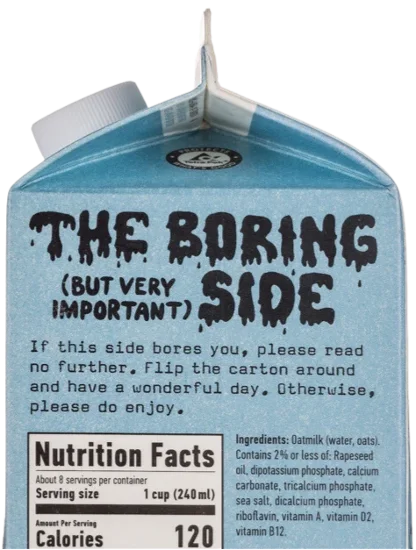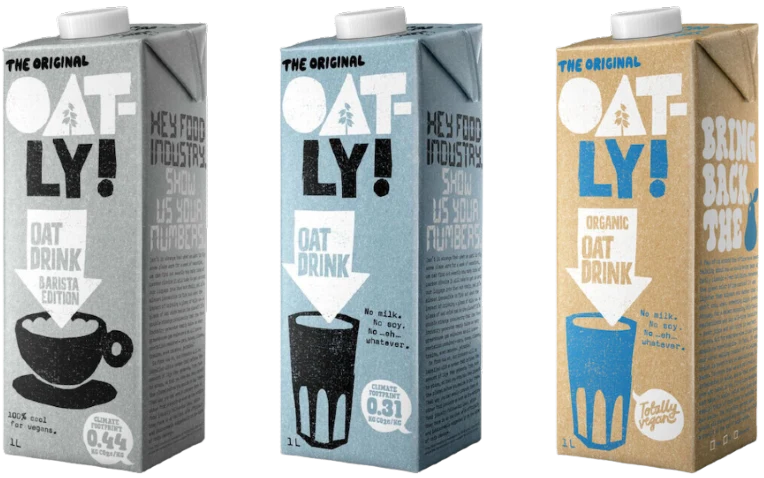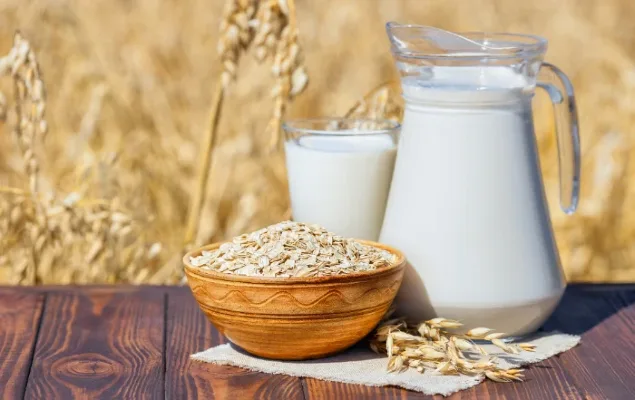Surely you’ve heard how bad cow’s milk is for the environment? So what’s the alternative, particularly if you’re one of those people who love to hop onto the next unproven, faux socially conscious trend that happens to have its own hashtag on social media?
Move aside soy, because there’s a new milk in town that’s taking the dairy alternative scene by storm: oat milk. It’s like milk, but made specifically for humans.
Let me break it down for you.
Oat Milk Origins
When Oatly, the Swedish company, introduced oat milk to the American market in 2016, they positioned it as the trendiest, most alluring milk out there. They claimed that oat milk is not only healthier than cow’s milk, but also suitable for anyone embracing a plant-based lifestyle for sustainability reasons.
Oatly’s marketing pitch convinced everyone to jump on the bandwagon. After all, oat milk looks and tastes like milk, foams up perfectly for lattes, and according to them, is even superior to the real deal.
However, the truth is that oats combined with water alone taste quite unpleasant.
How They Made It So We'd Drink It: Canola & Sugar!
To make commercial oat milk palatable, these companies load it up with copious amounts of seed oils and chemicals. We’re talking about additives like dipotassium phosphate, known to be linked to kidney disease and premature death, grape seed oil (a.k.a. canola oil), and maltose, a sugar with a glycemic load twice that of white sugar.
Surprisingly, one serving of oat milk has the same blood sugar impact as a can of Coke, and gram for gram, oat milk contains as much seed oil as a serving of french fries.
Clearly, these oat milk companies aren’t concerned about your well-being. Instead, oat milk is a clever marketing scheme—a ploy to make huge profits by selling imitation milk that costs far less to produce than real milk. It’s the great oat milk scam.

In fact, selling oat milk is a stroke of genius.
Why Oat Milk Is A Scam: Oat Milk vs Cow's Milk
Why?
Because oats are one of the cheapest crops available, costing a mere five cents per pound. With just five cents of oats, some water, and voilà, you can create 15 liters of oat milk. It’s a liquid goldmine with minimal production costs that can be sold at exorbitant prices in grocery stores.
Now, let’s compare this to real milk.
Dairy farmers work tirelessly, caring for their cows, milking them, and tending to their needs, just to produce milk that costs $1.11 per liter to make. Yet, they can only sell it for an average of $4.80 at the store.
Meanwhile, Oatly has the audacity to retail one liter of their product for a mind-boggling $5.00, despite the ridiculously cheap ingredients they use. It’s a simple equation—corporations prioritize growth and profits, and this oat milk trend is a surefire way to achieve them.
It's All About The Marketing
By introducing new marketing tactics, they can charge higher prices and rake in the profits. It’s no secret that these vegan processed foods often come with a higher price tag than their meat, dairy, and vegetable counterparts.
Sometimes, oat milk can even cost double the price of regular milk. But hold on, you can’t just mix oats and water in a box and expect consumers to fork over their hard-earned money for it.
Homemade oat milk without added sugar tastes like liquid garbage. To succeed, your product must taste divine. It has to look, feel, and most importantly, taste even better than cow’s milk.
And how do you make oat water taste like the real thing? Well, it takes a little bit of big food engineering.
What's Really In It?
Oatly, the mastermind behind oat milk, has crafted a flavor that’s like a symphony of sensations: mandarin strawberries, lemongrass, leather, lollipop, pineapples, pears, and bubblegum. They’ve certainly nailed the art of creating a wake-up call for your taste buds, evoking childhood memories. But why does Oatly taste like liquid ice cream, while homemade oat milk tastes less than appetizing, to put mildly? It all comes down to the enzymes.
Oatly adds an enzyme called amylase to their oat water mix, which essentially predigests the oats. This mimics the natural process that occurs in your mouth when saliva breaks down starchy foods into sugars.
However, this enzymatic breakdown of oats leads to the formation of a specific type of sugar: maltose.
And maltose is intensely sweet, with a glycemic index of 105. To put that in perspective, white sugar has a glycemic index of 65, and lactose, the sugar in cow’s milk, has an index of only 46.
Of course, Oatly doesn’t want the public to discover that their oat milk can send their blood sugar levels soaring.
That’s why they conveniently omit mentioning maltose on their ingredient list and proudly declare on their website that Oatly is cane sugar-free. Which, technically speaking, it is.
But as long as your milk tastes sweet, delicious, and makes people feel good, they won’t mind the sugar content. After all, they’re avoiding cow’s milk. The masses will continue guzzling it down.
However, creating the perfect oat milk recipe requires more than just enzymes. You also need to make it rich and creamy like real milk, which means incorporating some fat. But not just any fat—the cheapest you can find, like expeller-pressed canola oil, which is labeled as rapeseed oil on Oatly’s cartons.

Yes, Canola oil is actually called rapeseed oil.
Here’s the catch: canola oil contains trans fats. Unlike naturally occurring fats, trans fats are artificial and have been linked to various health issues, including Alzheimer’s disease, heart disease, breast cancer, colon cancer, and diabetes.
While the FDA banned trans fats in 2015, food companies are still allowed to include 0.5 grams per serving while claiming “0 grams of trans fats” on the packaging. Some products even contain up to 10% trans fats, despite the misleading labeling. To make matters worse, canola oil also contains aldehydes, a toxic compound found in oxidized seed oils, which has been shown to increase cancer risk. And apparently, the canola oil used in oat milk is heated and oxidized.
But wait, there’s more to achieving that coveted cow milk consistency.
You’ll need an emulsifier like dipotassium phosphate, which allows water and seed oils to blend together seamlessly. Dipotassium phosphate, originally derived from urine and animal bones, helps your oat milk froth up like a dream. Who cares if phosphate additives have been linked to chronic kidney disease, calcium deposits in the arteries, and higher rates of heart attacks in young men?
The Washington Post even likened phosphate additives to the next trans fats. But none of that matters when you have the perfect formula—a chemical concoction that convinces the world to abandon cow’s milk for good. Only one ingredient is missing: a marketing campaign to deceive the masses.
How They Make Us Want To Buy It?
The success of your artificial milk relies not only on its taste but also on effective marketing.
In the competitive food industry, shelf space is limited, so you need to convince people that drinking this chemical concoction is not only good for them but also cool. To accomplish this, you’ll hire a team of artists, writers, and marketing experts to lead Oatly’s Department of Mind Control. And yes, that’s actually what the Oatly CEO, Toni Petersson named the department.
Next, plaster every major city with Oatly propaganda. Create quirky YouTube videos with oat milk carton characters.
Revamp the packaging to exude a hip and trendy vibe, adorned with slogans like “Join the post-milk generation cult.”
You’ll even label the side listing the seed oils and chemicals as the “boring side.” Oh, and let’s not forget the ongoing debate within the company about whether Oatly can really be classified as milk. As long as the product is sweet, delicious, and makes people feel good, they’ll gladly switch from cow’s milk.
Baristas will play a crucial role in this marketing scheme. Once they witness how well your oat milk foams, they’ll enthusiastically promote it to their customers.
Soon enough, oat milk will become the latest craze at coffee shops like Starbucks. By employing multiple touchpoints to convey the message that Oatly is not only allegedly healthier than milk but also cool and environmentally friendly, you’ve successfully created a cult-like following to a product that’s mostly a greenwashing mass-produced con.
The Swedish dairy industry sued Oatly over the claim that their oat milk is like milk, but made for humans. Oatly lost and had to pay up. But that didn’t stop them from rolling out the same campaign in the US and UK a few months later.
How To Cultivate A Cult-Like Following Around Your Fake Healthy Greenwashed Product
Step 1: assemble a team of artists, writers, and marketing experts to establish Oatly’s Department of Mind Control.
Step 2: inundate major cities with Oatly propaganda.
Step 3: produce quirky YouTube videos featuring oat milk carton characters.
Step 4: revamp the packaging to exude a hip and trendy vibe, labeling the side that lists seed oils and chemicals as the “boring side.” You can even proudly proclaim that Oatly is part of the post-milk generation cult.
Step 5: distribute samples to baristas and convince them that your oat milk is the greatest thing since, well, cow’s milk. Baristas, in turn, will push oat milk on their customers, creating a massive frenzy.
And just like that, by employing various tactics to convey the message that Oatly is not only allegedly healthier than milk but also trendy and eco-friendly, you’ve successfully cultivated a devoted following.
Sales skyrocketed, with Oatly experiencing a staggering 200% growth in 2020, surpassing the modest 1% to 2% growth of other plant-based milk brands. However, success often attracts critics. Someone seems to have developed a sour attitude toward your achievements.
Bash The Competition
Cow’s milk, really?
As the head of Oatly’s Department of Mind Control, you took every opportunity to mock cow’s milk. You claimed that replacing it with oat milk would save the planet and that oat milk is healthier because it contains less saturated fat.
But let’s be honest, that’s a complete lie.
You plastered these claims everywhere, from commercials to print ads, and even on the oat milk cartons themselves. This didn’t sit well with dairy farmers, and what do big corporations do when they’re unhappy?
Now, Bring Out All The Lawyers
Yes, they bring out the lawyers in quantity!
In 2015, the Swedish Dairy Board sued you for defaming cow’s milk in your commercials, and they emerged victorious. You ended up paying around a hundred thousand dollars for the damage caused to their milk sales.
Eventually, a law was passed in Europe making it illegal for any company to label plant-based milk as “milk.” You had to call it a “drink” instead.

But did this setback deter you from pushing your chemical concoction to the masses?
Not at all. It only fueled your determination (and propaganda machine).
You went as far as publishing legal documents from the Dairy Board trial on your website and creating commercials that portrayed the Dairy Board as bullies, with you as the innocent victim.
Surprisingly, this strategy made you even more popular.
The public started seeing you as relatable, as the underdog. It was a stroke of marketing genius, and your sales continued to soar.
However, there was one small problem. You became so focused on your marketing campaign that you neglected to consider the fact that your small European factory couldn’t keep up with the overwhelming demand.
Grocery stores were running out of stock, and coffee shops were removing oat milk from their menus. You attempted to open another factory in New Jersey, but things didn’t progress quickly enough. Before you knew it, companies like Chobani and Earth’s Best introduced their own oat milk products, aiming to replace yours. The free market proved to be merciless.
But you still had one move left. So, faced with a thirsty mob at your doorstep and a milk shortage, you could have sold the company and made a swift exit. However, that would have meant wasting all the time and money you invested in building your cult following.
Let’s face it, only a fool would let go of such a lucrative business opportunity.
Instead, you decided to reach out to the Blackstone Group, one of the world’s largest investment firms.
You struck a deal where they invested 200 million dollars in exchange for a 10% stake in Oatly. This infusion of capital was exactly what you needed to ramp up production.
However, optically, your association with Blackstone wasn’t the wisest move.
After all, the Blackstone Group publicly supported, and financed, companies well known for their environmental destruction including Hidrovias Don Garcia, a Brazilian company accused of serious deforestation in the Amazon.

When your devoted followers discovered this connection, unknowingly supporting corrupt corporations through their loyalty to your brand, they were outraged. Social media erupted with threats of boycotting your products. The very reason people turned to Oatly in the first place was to reduce their carbon footprint. Or was that just another falsehood?
The Truth About Oat Milk, Including Those Carbon Footprint Claims
And what about those powerful carbon footprint reduction claims?
In 2021, the UK’s Advertising Standards Authority accused Oatly of making false claims about carbon emissions. It was discovered that the 73% reduction figure you often touted was based on consultation with just one climate expert.
Researchers like Jane Buxton found that dairy milk actually produced only one-third of the carbon emissions attributed to oat milk. So the idea that processed oat water would save the environment was nothing more than a blatant lie.
In the UK, dairy cows, beef cattle, and sheep combined contribute to just 7% of emissions. So why have we demonized cows? Interestingly, while cows do emit methane, so do many other sources, including wetlands, which account for 20% of all methane emissions.
So, Is Almond Milk or OJ Better?
Now, you might be thinking, “Okay, so oat milk isn’t great, but what about other nut milks? Maybe almond milk is a better option.”
I’m sorry to break it to you, but all these milk alternatives are essentially the same. They’re mostly water, a smattering of nuts of your choice, and a long list of toxic ingredients, including seed oils, emulsifiers, and numerous food additives. Real food is hardly present in these milk substitutes.
The almond milk in your fridge, for instance, contains almost no almonds. Granted, if it did, it would be much higher in calories. Nope, in reality, it’s mostly water, emulsifiers, gums, and oil. A typical eight-ounce cup of almond milk contains a mere five almonds, and the whole carton contains a paltry 2% almonds. So, if you’re expecting a healthy almond milk experience, think again.
Perhaps you’re considering switching to orange juice, thinking it’s a safe bet.
Take Simply Orange as an example. It’s just oranges, right? And it proudly states, “not from concentrate.” Unfortunately, there’s more to the story.
Simply Orange is owned by Coca-Cola, and they recently got entangled in a scandal that will make your blood boil. Coca-Cola, the parent company, was sued due to high levels of toxic forever chemicals found in their so-called all-natural Simply Tropical Juice. These forever chemicals, known as PFAS, are what make non-stick pans, well, non-stick. However, they’re also linked to liver damage, low birth weight, birth defects, delayed development, and even newborn deaths. The infuriating aspect is that these chemicals stay in your body indefinitely.
Simply’s products were found to contain over 100 times the EPA’s recommended levels of PFAS. But that’s a topic for another article, one that will surely leave you astounded.
More To Discover
- 10 Untold True Stories Behind America’s Favorite Breakfast Cereals
- Navigating Eco Certificates: What Are They Telling You (And What Are They Not Saying)
- The Breakfast Scam: America’s $42 Billion Propaganda War
- The Crazy Cereal Czar: Dr. John Harvey Kellogg’s Path to Cereal Icon Includes Extreme Beliefs, Celebrities, And Less Than Altruistic Adoptions
Conclusion: Morale Of The Story
What’s the morale of this story?
There isn’t one, because we’re all adults here. By now, we should all accept (and know) that companies market their products using deception. Sometimes it’s a little deception, and other times, it’s the size of an oat field. Regardless, that’s usually what marketing is when it comes to food companies.
No one is suggesting you stop enjoying oat milk, just, stop pretending that you pay a lot more for it because it’s good for the environment and healthier for your body. Neither of those things are true!
Drink it for the same reason you buy the 700 calorie mocha cappuccino, because you want to, and you like it. No justification needed!




















